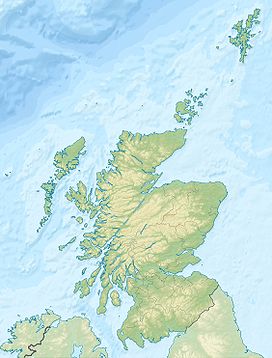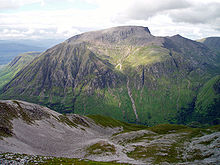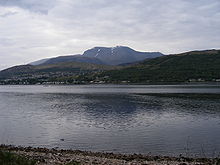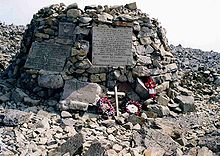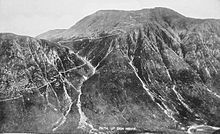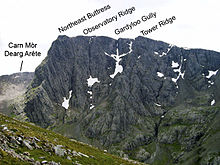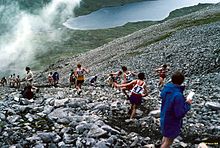
Ben Nevis
Background to the schools Wikipedia
SOS Children produced this website for schools as well as this video website about Africa. SOS Children has looked after children in Africa for forty years. Can you help their work in Africa?
| Ben Nevis | |
|---|---|
| Beinn Nibheis | |
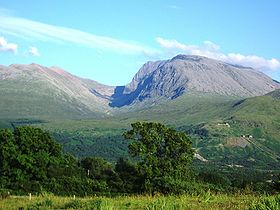 Ben Nevis from Banavie. The summit is beyond and to the left of the apparent highest point |
|
| Elevation | 1,344 m (4,409 ft) |
| Prominence | 1,344 m (4,409 ft) Ranked 1st in British Isles |
| Parent peak | none – HP Great Britain |
| Listing | Munro, Marilyn, Hardy, Council top ( Highland), County top ( Inverness-shire), Country high point |
| Translation | Venomous mountain or mountain with its head in the clouds ( Scottish Gaelic) |
| Location | |
| Scotland | |
| Location | Lochaber, Highland, Scotland |
| OS grid | NN 166 712 |
| Coordinates | 56°47′49″N 5°00′13″W Coordinates: 56°47′49″N 5°00′13″W |
| Topo map | OS Landranger 41, Explorer 392 |
| Climbing | |
| First ascent | 17 August 1771, by James Robertson |
| Easiest route | Walk |
Ben Nevis ( Scottish Gaelic: Beinn Nibheis, pronounced [peˈɲivəʃ]) is the highest mountain in the British Isles. Standing at 1,344 metres (4,409 ft) above sea level, it is located at the western end of the Grampian Mountains in the Lochaber area of the Scottish Highlands, close to the town of Fort William.
The mountain is a popular destination attracting an estimated 100,000 ascents a year, around three-quarters of which use the Pony Path from Glen Nevis. The 700-metre (2,300 ft) cliffs of the north face are among the highest in the United Kingdom, providing classic scrambles and rock climbs of all difficulties for climbers and mountaineers. They are also the principal locations in the UK for ice climbing.
The summit, which is the collapsed dome of an ancient volcano, features the ruins of an observatory which was continuously staffed between 1883 and 1904. The meteorological data collected during this period are still important for understanding Scottish mountain weather. C. T. R. Wilson was inspired to invent the cloud chamber after a period spent working at the observatory.
Etymology
"Ben Nevis" is an Anglicisation of the Scottish Gaelic name "Beinn Nibheis". "Beinn" is the most common Gaelic word for "mountain", "Nibheis" is variously understood, though the word is commonly translated as "malicious" or "venomous". An alternative interpretation is that "Beinn Nibheis" derives from "beinn nèamh-bhathais", from "nèamh" "heavens, clouds" and "bathais" "top of a man's head". One translation would therefore be "the mountain with its head in the clouds", though "mountain of Heaven" is also frequently given.
As is common for many Scottish mountains, it is known both to locals and visitors as simply "the Ben".
Geography
Ben Nevis forms a massif with its neighbour to the northeast, Càrn Mòr Dearg, to which it is linked by the Càrn Mòr Dearg Arête. Both mountains are among the nine in Scotland over 4,000 feet (1,200 m); Aonach Beag and Aonach Mòr also being located on the Nevis massif, with Ben Macdui, Braeriach, Cairn Toul, Sgor an Lochain Uaine and Cairn Gorm being located in the Cairngorms.
The western and southern flanks of Ben Nevis rise 1,200 metres (3,900 ft) in about 2 kilometres (1.2 mi) from the floor of Glen Nevis – the longest and steepest hill slope in Britain – with the result that the mountain presents an aspect of massive bulk on this side. To the north, by contrast, cliffs drop some 600 metres (2,000 ft) to Coire Leis. This corrie contains the Charles Inglis Clark Memorial Hut (known as the CIC Hut), a private mountain hut located at 680 metres (2,230 ft) above sea level, owned by the Scottish Mountaineering Club and used as a base for the many climbing routes on the mountain's north face.
In addition to the main 1,344 m (4,409 ft) summit, Ben Nevis has two subsidiary "tops" listed in Munro's Tables, both of which are called Càrn Dearg ("red hill"). The higher of these, at 1,221 metres (4,006 ft), is situated to the northwest, and is often mistaken for Ben Nevis itself in views from the Fort William area. The other Càrn Dearg (1,020 m) juts out into Glen Nevis on the mountain's southwestern side. A lower hill, Meall an t-Suidhe (711 metres (2,333 ft)), is located further west, forming a saddle with Ben Nevis which contains a small loch, Lochan an t-Suidhe. The popular tourist path from Glen Nevis skirts the side of this hill before ascending Ben Nevis' broad western flank.
Geology
Ben Nevis is all that remains of a Devonian volcano that met a cataclysmic end in the Carboniferous period around 350 million years ago. Evidence near the summit shows light coloured granite (which had cooled in subterranean chambers several kilometres beneath the surface) lies among dark basaltic lavas (that only form on the surface). The two lying side-by-side is evidence the huge volcano collapsed in on itself creating an explosion comparative to Thera ( 2nd millennium BC) or Krakatoa (1883). The mountain is now all that remains of the imploded inner dome of the volcano. Its form has been extensively shaped by glaciation.
Research has shown igneous rock from the Devonian period (around 400 million years ago) intrudes into the surrounding metamorphic schists; the intrusions take the form of a series of concentric ring dikes. The innermost of these, known as the Inner Granite, constitutes the southern bulk of the mountain above Lochan Meall an t-Suidhe, and also the neighbouring ridge of Càrn Mòr Dearg; Meall an t-Suidhe forms part of the Outer Granite, which is redder in colour. The summit dome itself, together with the steep northern cliffs, are composed of andesite and basaltic lavas.
Climate
Ben Nevis' altitude, maritime location and topography frequently lead to cool and cloudy weather conditions, which can pose a danger to ill-equipped walkers. According to the observations carried out at the summit observatory from 1883–1904, fog was present on the summit for almost 80% of the time between November and January, and 55% of the time in May and June. The average winter temperature was around −5 °C (23 °F), and the mean monthly temperature for the year was −0.5 °C (31.1 °F). In an average year the summit sees 261 gales, and receives 4,350 millimetres (171 in) of rainfall, compared to only 2,050 millimetres (81 in) in nearby Fort William, 840 millimetres (33 in) in Inverness and 580 millimetres (23 in) London. Rainfall on Ben Nevis is about twice as high in the winter as it is in the spring and summer. Snow can be found on the mountain almost all year round, particularly in the gullies of the north face – with the higher reaches of Observatory Gully holding snow until September most years and sometimes until the new snows of the following season.
| Climate data for Ben Nevis | |||||||||||||
|---|---|---|---|---|---|---|---|---|---|---|---|---|---|
| Month | Jan | Feb | Mar | Apr | May | Jun | Jul | Aug | Sep | Oct | Nov | Dec | Year |
| Average high °C (°F) | −2.5 (27.5) |
2.8 (37) |
−2.6 (27.3) |
−0.5 (31.1) |
2.6 (36.7) |
6.5 (43.7) |
7.1 (44.8) |
6.4 (43.5) |
5.3 (41.5) |
1.4 (34.5) |
0.1 (32.2) |
−2.0 (28.4) |
2.05 (35.68) |
| Average low °C (°F) | −6.3 (20.7) |
−6.4 (20.5) |
−6.3 (20.7) |
−4.3 (24.3) |
−1.6 (29.1) |
2.2 (36) |
3.1 (37.6) |
2.8 (37) |
1.4 (34.5) |
−2.1 (28.2) |
−3.5 (25.7) |
−5.5 (22.1) |
−2.21 (28.03) |
| Precipitation mm (inches) | 465 (18.31) |
344 (13.54) |
386 (15.2) |
215 (8.46) |
201 (7.91) |
191 (7.52) |
274 (10.79) |
339 (13.35) |
400 (15.75) |
392 (15.43) |
390 (15.35) |
484 (19.06) |
4,081 (160.67) |
| Source: | |||||||||||||
History
The first recorded ascent of Ben Nevis was made on 17 August 1771 by James Robertson, an Edinburgh botanist, who was in the region to collect botanical specimens. Another early ascent was in 1774 by John Williams, who provided the first account of the mountain's geological structure. John Keats climbed the mountain in 1818, comparing the ascent to "mounting ten St. Pauls without the convenience of a staircase". It was not until 1847 that Ben Nevis was confirmed by the Ordnance Survey as the highest mountain in Britain and Ireland, ahead of its rival Ben Macdui.
The summit observatory was built in the summer of 1883, and would remain in operation for 21 years. The first path to the summit was built at the same time as the observatory and was designed to allow ponies to carry up supplies, with a maximum gradient of one in five. The opening of the path and the observatory made the ascent of the Ben increasingly popular, all the more so after the arrival of the West Highland Railway in Fort William in 1894. Around this time the first of several proposals was made for a rack railway to the summit, none of which came to fruition.
In 2000, the Ben Nevis Estate, comprising all of the south side of the mountain including the summit, was bought by the Scottish conservation charity the John Muir Trust.
Ascent routes
The 1883 Pony Track to the summit (also known as the Ben Path, the Mountain Path or the Tourist Route) remains the simplest and most popular route of ascent. It begins at Achintee on the east side of Glen Nevis about 2 km (1.2 mi) from Fort William town centre, at around 20 metres above sea level. Bridges from the Visitor Centre and the youth hostel now allow access from the west side of Glen Nevis. The path climbs steeply to the saddle by Lochan Meall an t-Suidhe (also known as the 'Halfway Lake') at 570 m, then ascends the remaining 700 metres up the stony west flank of Ben Nevis in a series of zig-zags. It is allegedly well-made and maintained throughout its length, but the loose scree, rocks and pebbles, especially on the path's upper reaches, can be hazardous and slippery. Thanks to the zig-zags, the path is not unusually steep apart from in the initial stages, but inexperienced walkers should be aware that the descent is relatively arduous and wearing on the knees.
A route popular with experienced hillwalkers starts at Torlundy, a few miles north-east of Fort William on the A82 road, and follows the path alongside the Allt a' Mhuilinn. It can also be reached from Glen Nevis by following the Pony Track as far as Lochan Meall an t-Suidhe, then descending slightly to the CIC Hut. The route then ascends Càrn Mòr Dearg and continues along the Càrn Mòr Dearg Arête ("CMD Arête") before climbing steeply to the summit of Ben Nevis. This route involves a total of 1,500 metres of ascent and requires modest scrambling ability and a head for heights. In common with other approaches on this side of the mountain, it has the advantage of giving an extensive view of the cliffs of the north face, which are hidden from the Pony Track.
It is also possible to climb Ben Nevis from the Nevis Gorge car park at the head of the road up Glen Nevis, either by the south-east ridge or via the summit of Càrn Dearg (south-west). These routes do not require scrambling, but are shorter and steeper, and tend to be used by experienced hill walkers.
The summit
The summit of Ben Nevis comprises a large stony plateau of about 40 hectares (100 acres). The highest point is marked with a large, solidly built cairn atop which sits an Ordnance Survey trig point.
The ruined walls of the observatory are a prominent feature on the summit. An emergency shelter has been built on top of the observatory tower for the benefit of those caught out by bad weather, and, although the base of the tower is slightly lower than the true summit of the mountain, the roof of the shelter overtops the trig point by several feet, making it the highest man-made structure in the UK. A war memorial to the dead of World War II is located next to the observatory.
On 17 May 2006, a piano that had been buried under one of the cairns on the peak was uncovered by the John Muir Trust, which owns much of the mountain. The piano is believed to have been carried up for charity by removal men from Dundee over 20 years earlier.
The view from the UK's highest point is extensive. Under ideal conditions, it can extend to over 190 kilometres (120 mi), including such mountains as the Torridon Hills, Morven in Caithness, Lochnagar, Ben Lomond, Barra Head and to Knocklayd in County Antrim, Northern Ireland.
Observatory
A meteorological observatory on the summit was first proposed by the Scottish Meteorological Society (SMS) in the late 1870s, at a time when similar observatories were being built around the world to study the weather at high altitude. In the summer of 1881, Clement Lindley Wragge climbed the mountain daily to make observations (earning the nickname "Inclement Rag", leading to the opening on 17 October 1883 of a permanent observatory run by the SMS. The building was permanently manned until 1904, when it was closed due to inadequate Government funding. The twenty years' worth of readings still provide the most comprehensive set of data on mountain weather in Great Britain.
In September 1894, C. T. R. Wilson was employed at the observatory for a couple of weeks, as temporary relief for one of the permanent staff. During this period, he witnessed a Brocken spectre and glory, caused by the sun casting a shadow on cloud below the observer. He subsequently tried to reproduce these phenomena in the laboratory, resulting in his invention of the cloud chamber, used to detect ionising radiation.
Ben Nevis' popularity, climate and complex topography contribute to a high number of mountain rescue incidents. In 1999, for example, there were 41 rescues and four fatalities on the mountain. Some accidents arise over difficulties in navigating to or from the summit, especially in poor visibility. The problem stems from the fact that the summit plateau is roughly kidney-shaped, and surrounded by cliffs on three sides; the danger is particularly accentuated when the main path is obscured by snow. Two precise compass bearings taken in succession are necessary to navigate from the summit cairn to the west flank, from where a descent can be made on the Pony Track in relative safety.
In the late 1990s, Lochaber Mountain Rescue Team erected two posts on the summit plateau, in order to assist walkers attempting the descent in foggy conditions. These posts were subsequently cut down by climbers, sparking controversy in mountaineering circles on the ethics of such additions. Critics argued that cairns and posts are an unnecessary man-made intrusion into the natural landscape, which create a false sense of security and could lessen mountaineers' sense of responsibility for their own safety. Supporters of navigational aids pointed to the high number of accidents that occurred on the mountain (between 1990 and 1995 alone there were 13 fatalities, although eight of these were due to falls while rock climbing rather than navigational error), the long tradition of placing such aids on the summit, and the potentially life-saving role they could play. A series of solidly-constructed cairns currently (September 2009) marks the upper reaches of the Pony Track.
Climbing on Ben Nevis
The north face of Ben Nevis is riven with buttresses, ridges, towers and pinnacles, and contains many classic scrambles and rock climbs. It is of major importance for British winter climbing, with many of its routes holding snow often until late April. It was one of the first places in Scotland to receive the attention of serious mountaineers, with a descent of Tower Ridge in 1892 the earliest documented climbing expedition on the Ben. (It was not climbed from bottom to top for another two years). The Scottish Mountaineering Club's Charles Inglis Clark hut was built below the north face in Coire Leis in 1929. Because of its remote location, it is said to be the only genuine alpine hut in Britain. It remains popular with climbers, especially in winter.
Tower Ridge is the longest of the north face's four main ridges, with around 600 metres of ascent. It is not technically demanding (its grade is Difficult), and most pitches can be tackled unroped by competent climbers, but it is committing and very exposed. Castle Ridge, the first of the main ridges, is an easier scramble, while Observatory Ridge is graded Very Difficult; the latter is the closest ridge to the summit. Between the Tower and Observatory Ridges is Gardyloo Gully, which takes its name from the cry of "garde à l'eau" (French for "watch out for the water"), formerly used in Scottish cities as a warning when householders threw their slops out of a tenement window into the street. The gully's top wall was the refuse pit for the now-disused summit observatory. The North-east Buttress is the last and bulkiest of these four ridges, and is regarded as the hardest for its combination of technical difficulty and seriousness.
The north face contains dozens of graded rock climbs along its entire length, with particular concentrations on the Càrn Dearg Buttress (below the Munro top of Càrn Dearg NW) and around the North-east Buttress and Observatory Ridge. Classic rock routes include Rubicon Wall on Observatory Buttress (Severe) – whose second ascent in 1937, when it was considered the hardest route on the mountain, is described by W. H. Murray in Mountaineering in Scotland – and, on Càrn Dearg, Centurion (HVS) and Agrippa (E5).
Other classic routes were put up by Dr J. H. B. Bell and others between the Wars; these include Bell's 'Long Climb', at 1,400 ft (430 m) reputedly the longest on the mainland. Echo Wall, an extreme and as-yet ungraded climb was completed by Dave MacLeod in 2008 after two years of preparation.
The north face is also one of Scotland's foremost venues for winter mountaineering and ice climbing, and holds snow until quite late in the year; in a good year, routes may remain in winter condition until mid-spring. Most of the possible rock routes are also suitable as winter climbs, including the four main ridges; Tower Ridge, for example, is grade IV on the Scottish winter grading system, having been upgraded in 2009 by the Scottish Mountaineering Club after requests by the local Mountain Rescue Team, there being numerous benightments and incidents every winter season. Probably the most popular ice climb on Ben Nevis is The Curtain (IV,5) on the left side of the Càrn Dearg Buttress. At the top end of the scale, Centurion in winter is a grade VIII,8 face climb.
Ben Nevis Race
The history of hill running on Ben Nevis dates back to 1895. William Swan, a barber from Fort William, made the first recorded timed ascent up the mountain on or around 27 September of that year, when he ran from the old post office in Fort William to the summit and back in 2 hours 41 minutes. The following years saw several improvements on Swan's record, but the first competitive race was held on 3 June 1898 under Scottish Amateur Athletic Association rules. Ten competitors ran the course, which started at the Lochiel Arms Hotel in Banavie and was thus longer than the route from Fort William; the winner was 21-year-old Hugh Kennedy, a gamekeeper at Tor Castle, who finished (coincidentally with Swan's original run) in 2 hours 41 minutes.
Regular races were organised until 1903, when two events were held; these were the last for 24 years, perhaps due to the closure of the summit observatory the following year. The first was from Achintee, at the foot of the Pony Track, and finished at the summit; It was won in just over an hour by Ewen MacKenzie, the observatory roadman. The second race ran from new Fort William post office, and MacKenzie lowered the record to 2 hours 10 minutes, a record he held for 34 years.
The Ben Nevis Race has been run in its current form since 1937. It now takes place on the first Saturday in September every year, with a maximum of 500 competitors taking part. It starts and finishes at the Claggan Park football ground on the outskirts of Fort William, and is 14 kilometres (8.7 mi) long with 1,340 metres (4,400 ft) of ascent. Due to the seriousness of the mountain environment, entry is restricted to those who have completed three hill races, and runners must carry waterproofs, a hat, gloves and a whistle; anyone who has not reached the summit after two hours is turned back. As of 2010 the records have stood unbroken since 1984, when Kenny Stuart and Pauline Haworth of Keswick Athletic Club won the men's and the women's races with times of 1:25:34 and 1:43:25 respectively.
Environmental issues
Ben Nevis' popularity and high profile have led to concerns in recent decades over the impact of humans on the fragile mountain environment. These concerns contributed to the purchase of the Ben Nevis Estate in 2000 by the John Muir Trust, a Scottish charity dedicated to the conservation of wild places. The Estate covers 1,700 hectares of land on the south side of Ben Nevis and the neighbouring mountains of Càrn Mòr Dearg and Aonach Beag, including the summit of Ben Nevis.
The John Muir Trust is one of nine bodies represented on the main board of the Nevis Partnership. Founded in 2003, the Partnership, which also includes representatives from local government, Glen Nevis residents and mountaineering interests, works to "guide future policies and actions to safeguard, manage and where appropriate enhance the environmental qualities and opportunities for visitor enjoyment and appreciation of the Nevis area". Its projects include path repairs and improvements and the development of strategies for visitor management.
One of the Nevis Partnership's more controversial actions has concerned the large number of memorial plaques placed by individuals, especially around the summit war memorial. Many people believe that the proliferation of such plaques is inappropriate, and in August 2006 the Nevis Partnership declared an intention to eventually remove these plaques (after making efforts to return them to their owners), as part of a wider campaign to clean up the mountain.
In 2005, the amount of litter on the Pony Track was highlighted by national media, including BBC Radio 5 Live. Robin Kevan, a retired social worker from mid-Wales who is known as "Rob the Rubbish" for his efforts to clean up the countryside, then drove to Ben Nevis and cleaned the mountain himself, resulting in much media coverage and a concerted clean-up effort.
The Glen Nevis Centre have introduced a booking and charging system to groups undertaking ascents of Ben Nevis. The charge is being disputed.
Ben Nevis Distillery
The Ben Nevis Distillery is a single malt whisky distillery at the foot of the mountain, located by Victoria Bridge to the north of Fort William. Founded in 1825 by John McDonald (known as "Long John"), it is one of the oldest licensed distilleries in Scotland, and is a popular visitor attraction in Fort William. The water used to make the whisky comes from the Allt a' Mhuilinn, the stream that flows from Ben Nevis' northern corrie. "Ben Nevis" 80/- organic ale is, by contrast, brewed in Bridge of Allan near Stirling.
Other uses
Ben Nevis was the name of a White Star Line packet ship which in 1854 carried the group of immigrants who were to become the Wends of Texas. At least another eight vessels have carried the name since then.
Ben Nevis in Svalbard is a 922 metre-high mountain south of the head of Raudfjorden, Albert I Land, which was named after the Scottish hill.
